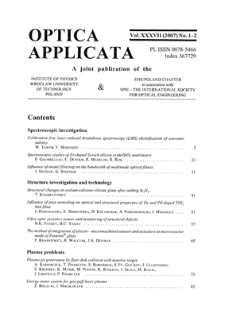Dolnośląska Biblioteka Cyfrowa udostępnia 109 805 obiektów cyfrowych
Obiekt
Tytuł: Calibration free laser-induced breakdown spectroscopy (LIBS) identification of seawater salinity
Autor:
Współtwórca:
Gaj, Miron. Redakcja ; Wilk, Ireneusz. Redakcja
Opis:
Optica Applicata, Vol. 37, 2007, nr 1-2, s. 5-19
Abstrakt:
Wydawca:
Oficyna Wydawnicza Politechniki Wrocławskiej
Miejsce wydania:
Data wydania:
Typ zasobu:
Identyfikator zasobu:
Źródło:
<sygn. PWr A3481II> ; kliknij tutaj, żeby przejść ; kliknij tutaj, żeby przejść
Język:
Powiązania:
Optica Applicata ; Optica Applicata, Vol. 37, 2007 ; Optica Applicata, Vol. 37, 2007, nr 1-2 ; Politechnika Wrocławska. Wydział Podstawowych Problemów Techniki
Prawa:
Wszystkie prawa zastrzeżone (Copyright)
Prawa dostępu:
Dla wszystkich w zakresie dozwolonego użytku
Lokalizacja oryginału:
Kolekcje, do których przypisany jest obiekt:
- Dolnośląska Biblioteka Cyfrowa > Uczestnicy Konsorcjum > 01. Politechnika Wrocławska > Czasopisma > Wydane w PWr > Optica Applicata
- Dolnośląska Biblioteka Cyfrowa > Zasoby > 2. Czasopisma > Czasopisma współczesne
- Dolnośląska Biblioteka Cyfrowa > Dziedziny nauki > 6. Nauki ścisłe i przyrodnicze
Data ostatniej modyfikacji:
27 mar 2019
Data dodania obiektu:
27 paź 2011
Liczba wyświetleń treści obiektu:
788
Wszystkie dostępne wersje tego obiektu:
https://dbc.wroc.pl/publication/12919
Wyświetl opis w formacie RDF:
Wyświetl opis w formacie OAI-PMH:
| Nazwa wydania | Data |
|---|---|
| Calibration free laser-induced breakdown spectroscopy (LIBS) identification of seawater salinity | 27 mar 2019 |
Obiekty Podobne
Hassini, Abdellatif Dejean, Sebastien Benabadji, Noureddine Hassini, Noureddine Belbachir, Ahmed Hafid Gaj, Miron. Redakcja Urbańczyk, Wacław. Redakcja
Kardas, Aleksandra E. Markowicz, Krzysztof M. Stelmaszczyk, Kamil Karasiński, Grzegorz Malinowski, Szymon P. Stacewicz, Tadeusz Woeste, Ludger Hochhertz, Carsten Gaj, Miron. Redakcja Urbańczyk, Wacław. Redakcja
Mihoub, Zakarya Hassini, Abdelatif Urbańczyk, Wacław. Redakcja
Otremba, Zbigniew Gaj, Miron. Redakcja Wilk, Ireneusz. Redakcja
Stankevich, Sergey Titarenko, Olga Svideniuk, Mykhailo Kharytonov, Mykola Benselhoub, Aissa Khlopova, Valentine Hardygóra, Monika. Redakcja Szyszka, Danuta. Redakcja
Kostikov, Eva Iqbal, Zahid Bushra, Mehmood Drelich-Skulska, Bogusława. Redakcja Sobocińska, Magdalena. Redakcja Tomášková, Andrea. Redakcja
Romanowski, Andrzej Gaj, Miron. Redakcja
Dobierzewska-Mozrzymas, Ewa Gaj, Miron. Redakcja
























